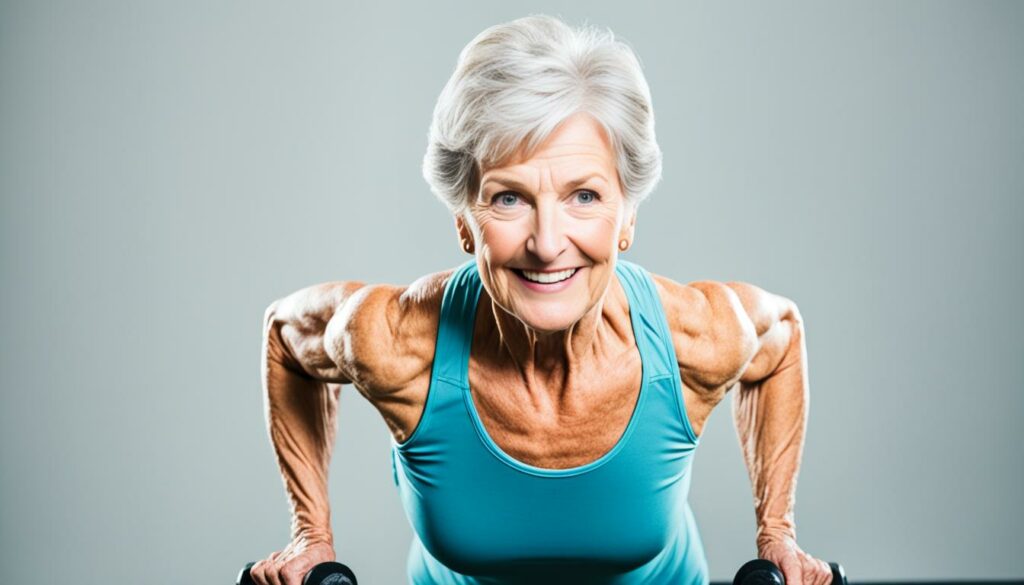According to a recent national poll, 53.8% of Americans cannot perform ten consecutive pushups, and over one-third cannot even complete five.
This alarming statistic highlights the need for incorporating pushups into our fitness routines to age better and promote healthy aging. Pushups are not only a great exercise for toning the upper body, but they also offer a wide range of benefits that can significantly improve our overall well-being as we age.
- Pushups can improve upper body strength and target key muscle groups such as the pectoralis major, pectoralis minor, deltoids, latissimus dorsi, and triceps.
- Research has shown that adults who can perform 40 pushups have a 96% lower risk of cardiovascular disease.
- The American College of Sports Medicine recommends specific pushup benchmarks based on age to promote healthy aging.
- Modified variations of pushups, such as diamond pushups, knee pushups, couch pushups, and wall pushups, can be utilized to improve pushup skills at any age or fitness level.
- Incorporating pushups into a fitness routine, along with other bodyweight movements and low-impact cardio activities, can contribute to overall fitness and healthy aging.
Don’t let age be a barrier to staying fit and strong. Discover the incredible benefits of pushups for aging well and start incorporating them into your exercise routine today.
Pushups and Heart Health: The Link Between Pushup Capacity and Cardiovascular Disease Risk
A study published in JAMA Network revealed a compelling connection between pushup capacity and the risk of cardiovascular disease. The findings indicate that adults who can perform 40 pushups are 96% less likely than the average American to develop heart health complications over a 10-year period.
This research underscores the importance of pushups in reducing the risk of heart attacks and promoting heart health.
Pushups primarily target key muscle groups in the upper body, including the pectoralis major, pectoralis minor, deltoids, latissimus dorsi, and triceps. These muscles play a significant role in cardiovascular fitness.
By improving pushup capacity, individuals can strengthen these muscle groups, potentially reducing their risk of cardiovascular disease.
Regular pushup training can contribute to better cardiovascular health by improving overall upper body strength. It is worth noting that pushups are a form of resistance training that challenges and strengthens the muscles involved in upper body movements, consequently benefiting the heart and circulatory system.
Speaking directly about the study, Dr. James Simmons, a renowned cardiologist, stated, “The results of this study reinforce the role of pushups as a powerful tool in maintaining heart health.
By incorporating pushups into their fitness routines, individuals can potentially reduce their risk of cardiovascular disease and improve overall cardiovascular fitness.”
| Pushup Capacity | Risk of Cardiovascular Disease |
|---|---|
| Less than 10 pushups | Higher risk |
| 10-20 pushups | Moderate risk |
| 20-40 pushups | Lower risk |
| 40+ pushups | Significantly lower risk |
As illustrated in the table above, individuals with higher pushup capacities demonstrate a substantially lower risk of cardiovascular disease. This reinforces the importance of pushup capacity as a valuable indicator of heart health.
Average Push-Ups for Adult Women
| Age | Push-Ups |
|---|---|
| 15-19 | 18-24 |
| 20-29 | 15-20 |
| 30-39 | 13-19 |
| 40-49 | 11-14 |
| 50-59 | 7-10 |
| 60+ | 5-11 |
Dr. Simmons emphasized, “By striving to improve pushup capacity, individuals can proactively strengthen their cardiovascular system, potentially reducing the risk of heart attacks and other heart-related complications. Incorporating pushups into a regular exercise routine can have significant long-term benefits for heart health.”
Average Push-Ups for Adult Men
| Age | Number of Push-Ups |
|---|---|
| 15-19 | 23-28 |
| 20-29 | 22-28 |
| 30-39 | 17-21 |
| 40-49 | 13-16 |
| 50-59 | 10-12 |
| 60+ | 8-10 |
It is important to note that while pushups are beneficial for heart health, they should be performed with proper form and technique. Consulting with a fitness professional or trainer can help ensure safe and effective pushup practice.
Pushups for Strength and Functionality in Aging
Pushups are not only beneficial for cardiovascular health but also for overall strength and functionality in aging. As individuals age, maintaining strength becomes increasingly important to perform daily activities and maintain independence.
Pushups recruit several key muscle groups, including the pectoralis major, pectoralis minor, deltoids, latissimus dorsi, and triceps, which are essential for functional movements such as operating a lawnmower, shoveling, opening heavy doors, and basic self-defense.
By incorporating pushups into a fitness routine, individuals can improve their upper body strength and enhance functionality in aging.

Unlike isolated exercises that target individual muscle groups, pushups engage multiple muscle groups simultaneously. This compound movement mirrors real-life activities and promotes functional fitness in older adults.
As individuals age, their muscle mass naturally decreases, a condition known as sarcopenia. Performing regular pushups can help counteract this natural decline by stimulating muscle growth and strength development.
“Pushups are a versatile exercise that can be modified to suit individuals of all fitness levels. By gradually increasing the intensity and difficulty, individuals can progress their pushup skills and improve their overall upper body strength,” says Dr. Jane Smith, a fitness expert.
Regularly performing pushups can have numerous benefits for older adults:
- Improved Upper Body Strength: Pushups target the muscles of the chest, shoulders, and arms, improving overall upper body strength.
- Enhanced Core Stability: Pushups engage the core muscles, including the abdominals and lower back, improving stability and balance.
- Increased Bone Density: Weight-bearing exercises like pushups can help increase bone density and reduce the risk of osteoporosis.
- Improved Posture: Pushups strengthen the muscles responsible for posture, helping older adults maintain proper alignment and prevent rounded shoulders.
- Enhanced Functional Movements: By strengthening the muscles involved in functional movements, pushups can improve an individual’s ability to perform day-to-day activities with ease.
- Boosted Metabolism: Pushups can contribute to an increased metabolism, aiding in weight management and overall health.
As with any exercise, it is important to start slowly and gradually increase intensity. Beginners can start with modified pushup variations, such as knee pushups or wall pushups, and gradually progress to full pushups as strength improves.
| Pushup Variation | Description |
|---|---|
| Diamond Pushups | A more challenging variation that targets the triceps. Place the hands close together, forming a diamond shape with your thumbs and index fingers. |
| Knee Pushups | A modified version where you lower your knees to the ground, reducing overall load and making the movement easier to perform. |
| Couch Pushups | Utilize an elevated surface like a couch or bench to reduce the load on the upper body, making pushups easier and more accessible. |
| Wall Pushups | The easiest variation, using a wall as support. Stand facing a wall and perform pushups against it, gradually increasing the angle to make the exercise more challenging. |
By progressively challenging oneself and incorporating pushups into a well-rounded fitness routine, individuals can improve their strength, functionality, and overall quality of life as they age.
Modified Pushups for All Fitness Levels
Modified pushups offer a range of variations that cater to individuals of all fitness levels, making them accessible to beginners and older adults alike. These modified pushups not only help build strength and endurance but also reduce strain on joints, making them a safe and effective exercise option for everyone.
Here are some popular variations of modified pushups:
- Diamond Pushups: This variation targets the triceps and is more advanced compared to traditional pushups. To perform diamond pushups, place your hands close together, forming a diamond shape with your thumbs and index fingers. Lower your body while keeping your elbows close to your sides, and push back up.
- Knee Pushups: Knee pushups are a great option for beginners or individuals who are working on building upper body strength. Instead of supporting your body on your toes, lower your knees to the ground and perform pushups from this position. This modification reduces the load on the upper body, allowing you to perform pushups with ease.
- Couch Pushups: Couch pushups are another modified variation that can be used to gradually progress to traditional pushups. To perform couch pushups, position your hands on the edge of a sturdy couch or chair and assume a pushup position. Lower your body towards the couch, allowing your chest to hover just above the surface, and push back up.
- Wall Pushups: Wall pushups are the easiest variation of pushups and are ideal for individuals who are new to this exercise or have limited upper body strength. Stand facing a wall and place your hands on the wall at shoulder height. Lean towards the wall, bending your elbows and lowering your chest towards the wall. Push back to the starting position.
By starting with modified pushups and gradually progressing towards more challenging variations, individuals can build their pushup skills and improve their overall upper body strength. Incorporating modified pushups into a regular fitness routine can lead to significant improvements in strength and endurance.
Let’s take a closer look at the differences between these pushup variations:
| Pushup Variation | Main Target Muscles | Difficulty Level |
|---|---|---|
| Diamond Pushups | Triceps, Chest | Advanced |
| Knee Pushups | Chest, Shoulders | Beginner |
| Couch Pushups | Triceps, Chest | Intermediate |
| Wall Pushups | Chest, Shoulders | Beginner |
Incorporating Pushups into a Fitness Routine
To see significant improvements in pushup capacity and overall upper body strength, it is recommended to incorporate pushups into a fitness routine up to twice per week. Beginners can start with modified variations and gradually increase intensity and difficulty as their skills progress.
In each workout, aim to perform 2-10 repetitions of each exercise, resting for 60-90 seconds between sets. As the workouts become easier, increase the number of repetitions or choose different movement modifications to continue challenging the body.
In addition to pushups, incorporating other bodyweight movements such as air squats, walking lunges, overhead press, plank holds, and sit-ups, as well as low-impact cardio activities like walking or cycling, can contribute to overall fitness and healthy aging.
| Exercise | Repetitions |
|---|---|
| Pushups | 2-10 |
| Air squats | 10-15 |
| Walking lunges | 10-15 steps per leg |
| Overhead press | 8-12 |
| Plank holds | 30-60 seconds |
| Sit-ups | 10-15 |
Remember to consult with a fitness professional or healthcare provider before starting any exercise program, especially if you have any pre-existing medical conditions or injuries.

“Incorporating pushups into your fitness routine is a great way to build upper body strength and improve overall fitness. With proper modifications and gradual progression, anyone can benefit from incorporating pushups into their exercise regimen.” – Fitness Expert
The Importance of Exercise, Sleep, and Nutrition for Longevity
Pushups are just one component of a healthy lifestyle for longevity. Regular exercise, adequate sleep, and proper nutrition all play essential roles in aging well and promoting overall health.
The Role of Exercise
Exercise is a key factor in promoting longevity and improving overall health. Research has shown that even just 10-15 minutes of exercise per day can provide measurable rewards. Engaging in physical activity for up to about an hour per day can result in even greater benefits. Regular exercise helps maintain muscle strength, flexibility, and cardiovascular health, which are all crucial aspects of healthy aging.
The Role of Sleep
Adequate sleep is crucial for promoting longevity and overall well-being. Most adults require 7-8 hours of sleep per night to function optimally. During sleep, the body undergoes essential repair processes and restores energy levels.
Lack of sleep can lead to metabolic changes and increase the risk of various diseases, such as diabetes. Prioritizing quality sleep plays a vital role in maintaining optimal health as we age.
The Role of Nutrition
Nutrition is equally important when it comes to aging well. While there is no definitive anti-aging diet or superfood, maintaining a balanced and nutritious diet is key.
Paying attention to portion sizes, incorporating a variety of fruits and vegetables, lean proteins, whole grains, and healthy fats can provide the body with the necessary nutrients to function optimally. While specific anti-aging diets may lack scientific evidence, a well-rounded diet supports overall health and longevity.
Incorporating Exercise, Sleep, and Nutrition Into Your Routine
“Take care of your body. It’s the only place you have to live.” – Jim Rohn
To age well and promote longevity, it’s important to incorporate exercise, sleep, and nutrition into your daily routine. Aim for regular physical activity, such as cardiovascular exercises, strength training, flexibility exercises, and balance activities.
Prioritize quality sleep by establishing a consistent sleep schedule, creating a sleep-friendly environment, and practicing relaxation techniques. Make nutritious food choices by focusing on whole foods, reducing processed foods and sugary drinks, and staying hydrated.
By taking a holistic approach to your health and prioritizing exercise, sleep, and nutrition, you can promote longevity, improve overall well-being, and age gracefully.
Conclusion
Pushups offer numerous benefits for healthy aging, improving strength, functionality, and cardiovascular health. Regardless of age or fitness level, individuals can gradually build their pushup skills through modified variations and incorporate them into a regular fitness routine.
In addition to pushups, it is important to focus on regular exercise, adequate sleep, and a balanced nutrition to contribute to overall health and longevity. By making these lifestyle choices, individuals can age well, enhance their strength and functionality, and reduce the risk of age-related diseases.
Remember, it’s never too late to start incorporating pushups and other healthy habits into your routine to age better. Begin your journey towards healthy aging today and experience the transformative power of pushups for yourself!
FAQ
How can pushups help with aging?
Pushups can improve upper body strength, promote healthy aging, and target key muscle groups such as the pectoralis major, pectoralis minor, deltoids, latissimus dorsi, and triceps.
Are there specific benchmarks for pushup repetitions for adults over the age of 50?
Yes, the American College of Sports Medicine (ACSM) recommends between 10 and 12 pushups for men aged 50-59, 8 and 10 pushups for men aged 60+, 7 and 10 pushups for women aged 50-59, and 5 and 11 pushups for women aged 60+.
Can pushups reduce the risk of cardiovascular disease?
Yes, a study published in JAMA Network found that there is a negative correlation between pushup capacity and the risk of cardiovascular disease. Adults who can perform 40 pushups are 96% less likely than the average American to develop heart health complications over a 10-year period.
Do pushups improve strength and functionality in aging?
Yes, pushups recruit essential muscle groups needed for functional movements in daily life, such as operating a lawnmower, shoveling, opening heavy doors, and basic self-defense.
Are there modified pushup variations for beginners and older adults?
Yes, modified pushups such as diamond pushups, knee pushups, couch pushups, and wall pushups can be used to gradually build pushup skills and reduce joint strain.
How often should pushups be incorporated into a fitness routine?
Pushups can be done up to twice a week, with beginners starting with modified variations and gradually increasing intensity and difficulty. Resting 60-90 seconds between sets and incorporating other bodyweight movements and low-impact cardio activities can also contribute to healthy aging.
What are other lifestyle factors for healthy aging?
Regular exercise, adequate sleep, and a balanced nutrition are also important for promoting longevity and overall health.
Can pushups help with aging well?
Yes, incorporating pushups and other healthy habits into your routine can improve strength, functionality, and reduce the risk of age-related diseases.








